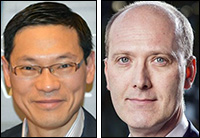Communications service providers (CSPs) are already the trusted stewards of a lot of data considered valuable across industries and organizations, but with the rise of 5G and the Internet of Things (IoT), the data they have at hand will continue to skyrocket in both size and value. The time is right for CSPs to explore strategies to turn this valuable asset into significant, new streams of revenue.
In early 2018, Ericsson published a report that examined how CSPs were taking advantage of their place in the IoT value chain to maximize opportunities, but the dialogue didn’t stop there. Through strategic engagements with their CXOs, we continue to help them realize their strategies to leverage their unique position in the value chain to generate revenue.

The result of these learnings is a new report that reveals how leading global CSPs are monetizing their IoT data. “Realizing IoT Strategies” presents our eight-dimension strategic framework that ensures a holistic 5G and IoT strategy planning and execution, along with three in-depth case studies that illustrate how leading CSPs are turning their 5G and IoT visions into revenue-generating realities.
Case Study #1: 5G and IoT Strategy
To remain competitive amidst the digital transformation, CSPs should leverage their existing assets to evolve their core business. In addition to deploying high-performance networks, they need to move beyond their historically connectivity-centric approach to explore new growth enabled by 5G and the IoT. In mapping their paths to success, we found that, of the eight dimensions in our framework, these five present CSPs with the most challenge:
• Strategic intent: CSPs tend to be too technology-focused and lack a long-term strategic intent in 5G and IoT.
• Enterprise focus: CSPs’ opportunistic approach to predominantly targeting enterprises means their focus is diluted across many sectors.
• Value chain position: Many leading CSPs want to assume larger roles higher up in the IoT stack, but they often underestimate the capabilities required to reach a position beyond connectivity and network provisioning.
• Go-to-market / ecosystem strategy: CSPs are currently attempting to develop the required capabilities in-house and to build solid partnerships for execution.
• Operating model: CSPs commonly operate in silos, with isolated enterprise and network departments, causing disjointed strategic and operational directions on 5G and IoT.
Case Study #2: Data Monetization
Data has risen to become one of the world’s most valuable assets. Advancements in artificial intelligence and machine learning are making it possible to turn vast amounts of data into actionable business intelligence. However, to gain these insights, organizations first need access to data, whether collected on their own or procured from an outside source.
The ongoing evolution of how data is shared sets the stage for CSPs to become relevant, and four data monetization tactics have been identified for them:
• Leveraging primary IoT use case data
• Aggregating data in a data lake
• Brokering data on a data marketplace
• Building additional applications
As the IoT market matures and data is shared across industries and supply chains, the importance of the role of the data broker will rise.
Case Study #3: Transport and Logistics
The transport and logistics industry is set to greatly benefit from 5G and IoT progress, and CSPs are in pole position to provide enormous value to organizations in this race. Top global CSPs’ current transport and logistics offerings vary widely, spanning the entire IoT value stack. Some approach it from a connectivity perspective (e.g. embedded connectivity), while others from an end-to-end solution (e.g. fleet management) or a platform perspective (e.g. V2X).
CSPs’ focus areas are shifting, however, with some demonstrating a notable emphasis on location data brokering and becoming data-exchange providers, mainly due to their ability to collect massive amounts of location and movement data. Other future opportunities include global embedded connectivity, infrastructure connectivity and V2X services.
Within location data brokering specifically, we have been working with CSPs that aim to monetize data by targeting five opportunities:
• Location-based marketing
• City and infrastructure planning
• Smart traffic
• Field services
• Public safety
CSPs possess unique strengths that give them a competitive advantage to provide significant value within the fast-growing 5G and IoT space: ubiquitous and secure networks, highly reliable connectivity, device and data management capability, and access to enormous amounts of data. The key to success lies within leveraging these advantages in concert with a clear and holistic strategic vision.
To learn more about how to turn a holistic 5G and IoT strategy into execution that leads to increased revenue, please read our new report, “Realizing IoT Strategies.”
Warren Chaisatien is Ericsson‘s global head of IoT customer engagement marketing. Jan Abrahamsson is the company’s strategic customer engagement manager.

